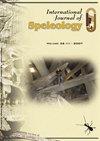Cosmogenic nuclide dating of cave sediments in the Eastern Alps and implications for erosion rates
IF 1.3
4区 地球科学
Q3 GEOSCIENCES, MULTIDISCIPLINARY
引用次数: 12
Abstract
Karstic caves are created by water eroding and corroding rocks that can be dissolved. Since both the spring areas of caves (normally at the valley bottom) as well as the recharge is controlled by superficial processes, the morphology of the cave bears strong links to these influences. Lowering of local base levels promotes the development of horizontal phreatic cave passages at progressively lower elevations, resulting in the formation of multi-level karst systems. Upon the next lowering of base level, these upper systems become fossilized, and sediment trapped within them may remain preserved for millions of years. Dating these sediments gives clues regarding the time when the passages were last active, and thus may yield age information for old valley floors. The present paper presents cosmogenic nuclide datings of twelve samples from eight caves in the central part of the Northern Calcareous Alps of Austria. Besides three samples that gave no results, most of the obtained ages are at the Mio-Pliocene boundary or within the Pliocene, as was expected before sampling. No multi-level caves could be sampled at different elevations, thus, the obtained valley deepening rates are averages between the age of sediment deposition and the present-day valley floor. However, the valley deepening rates of 0.12 to 0.21 km/Ma are in accordance to previous findings and corroborate a comparatively slow evolution of base level lowering in the Eastern Alps compared to the fast (Late Quaternary) evolution in the Central and Western Alps.东阿尔卑斯洞穴沉积物的宇宙成因核素测年及其对侵蚀率的影响
岩溶洞穴是由水侵蚀和腐蚀可以溶解的岩石形成的。由于洞穴的泉域(通常位于谷底)和补给都受到浅层过程的控制,洞穴的形态与这些影响有着密切的联系。局部基准面的降低促进了水平潜水洞穴通道在海拔逐渐降低的情况下的发展,从而形成了多级岩溶系统。在下一次基准面下降时,这些上层系统会变成化石,被困在其中的沉积物可能会保存数百万年。这些沉积物的年代测定为通道最后一次活动的时间提供了线索,因此可能产生旧谷底的年龄信息。本文介绍了奥地利北部钙质阿尔卑斯山脉中部8个洞穴中12个样品的宇宙成因核素定年。除了三个没有给出结果的样本外,大多数获得的年龄都在中上新世边界或上新世内,正如采样前所预期的那样。在不同的海拔高度无法对多层洞穴进行采样,因此,获得的山谷加深率是沉积物沉积年龄和当今谷底之间的平均值。然而,0.12至0.21 km/Ma的山谷加深率与之前的研究结果一致,并证实了与阿尔卑斯山脉中部和西部的快速(晚第四纪)演变相比,阿尔卑斯山脉东部的基准面下降演变相对缓慢。
本文章由计算机程序翻译,如有差异,请以英文原文为准。
求助全文
约1分钟内获得全文
求助全文
来源期刊

International Journal of Speleology
地学-地球科学综合
CiteScore
3.10
自引率
23.10%
发文量
12
审稿时长
>12 weeks
期刊介绍:
The International Journal of Speleology has the aim to get cave and karst science known to an increasing number of scientists and scholars. The journal therefore offers the opportunity to all scientists working in and on karst to publish their original research articles or their review papers in an open access, high quality peer reviewed scientific journal at no cost. The journal offers the authors online first, open access, a free PDF of their article, and a wide range of abstracting and indexing services.
 求助内容:
求助内容: 应助结果提醒方式:
应助结果提醒方式:


